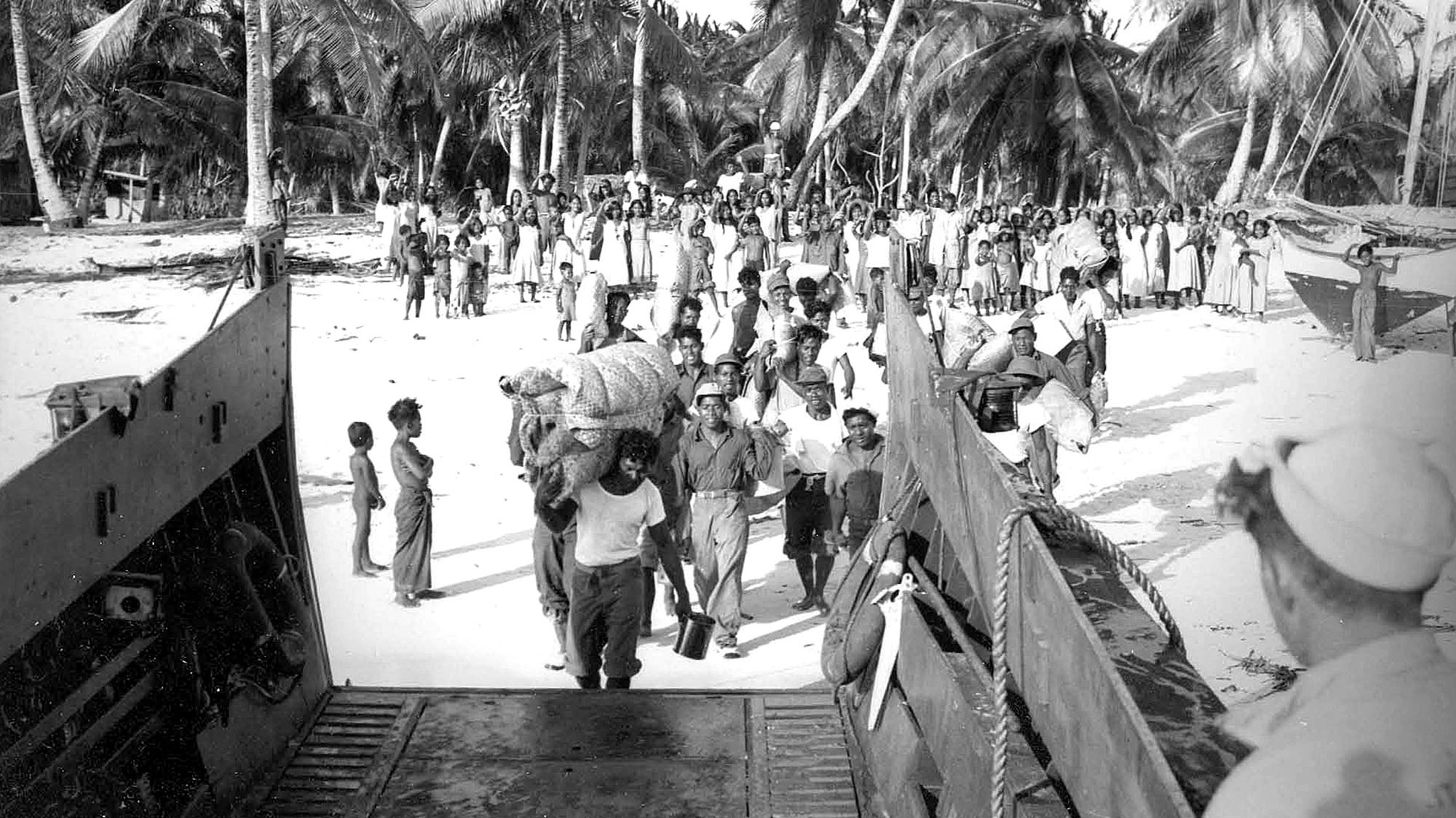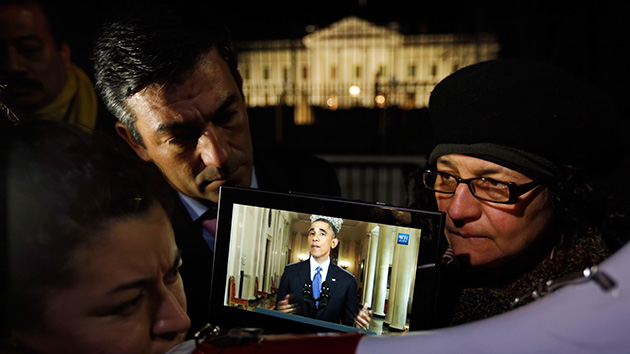The migration began shortly after sundown. For most of the encampment’s residents, it had become routine. State officials had swept the park and rousted its inhabitants four times the previous week, and four times the week before that. The residents started by taking down their roofs—tarps, mostly, sometimes patched together with umbrellas. Next came the walls: tents for those who had them, cardboard and sheets for those who didn’t. Finally, they packed up their possessions. No one had many of these. A few sleeping pads and blankets, and maybe some mementos.
Some of the residents loaded their belongings into shopping carts and pushed them down Ilalo Street, away from the park they’d called home since the last sweep. One man pulled his things in a child’s red wagon. A few people attached carts to their bicycles and pedaled northwest, as night fell on the palm trees and grassy squares of Kakaako Waterfront Park, the beachside public recreation area just south of Honolulu’s downtown.
Jaymiola and Jerana had no carts or wagons or bicycles. The sisters gathered up their bedding in their arms, while a companion hoisted their tent over his head for the half-mile trek to Ala Moana Boulevard. Their family used to have two tents, one for the women and girls and another for the men and boys. But the other one, the bigger one, had been thrown out during an earlier sweep, they said. Now the five female family members crowded into the neon green tent—which could maybe, generously, be termed a three-person tent—while the males stayed with friends and relatives in the park.
Jerana, 21, is petite and reticent around strangers. Jaymiola, 18, is taller and more outgoing. But the sisters have the same shy smile, wear their hair in the same bun, and have a habit of completing each other’s sentences. They’re also two of the approximately 8,000 homeless residents of Hawaii. (These are the names they gave me, spelling them patiently but making no pretense of authenticity—hardly any homeless residents I spoke to for this story wanted to use their real names.) The state has the highest rate of homelessness of any in the country, and Honolulu has more homeless than any comparably sized city.
But Hawaii’s homeless epidemic has masked another crisis, one that implicates the highest levels of the US government and has left thousands of legal US residents mired in poverty and homelessness. Jaymiola and Jerana’s family came to Hawaii, via Guam, from the island state of Chuuk in the Federated States of Micronesia (FSM). The FSM and two other countries in the Micronesian region have a special relationship with the United States, one that cedes huge swaths of the Pacific Ocean to US military control and gives Micronesians the ability to come freely to America to work and live.
But the federal government has revoked some of the benefits previously available to Micronesians, leaving them unable to afford the health care many of them came for and the high cost of living in Hawaii, their main destination. With climate change inundating the Pacific islands and rendering them increasingly uninhabitable, the flow of migrants is likely to grow in the coming years, along with the struggles of the Micronesians who come to America in search of something better.
“I anticipate that within the next 20 years, it would be so explosive that that’s going to be another significant challenge for US policymakers,” said Esther Kia’aina, the US assistant secretary of the interior for insular affairs.
Homeless residents per 10,000 inhabitants
Jaymiola wore a tank top with a faded American flag on the front as she gathered her possessions from Kakaako Waterfront Park, also known as Point Panic Beach Park, named for a surf break off the shore. It became the focus of public alarm last year, when Jaymiola and Jerana and hundreds of other homeless residents set up camp there, many of them forced off city sidewalks in response to pressure from neighbors and businesses. The park is controlled by the state government, which began conducting patrols to enforce the park’s nighttime curfew, pushing residents back out onto city sidewalks along busy Ala Moana Boulevard and nearby streets.
“They try to kick us out of the park, but we have nowhere to go,” said Jaymiola. “So we just come back.”
Migration has defined Jaymiola and Jerana’s lives since they arrived in Honolulu four years ago. In the first public housing complex they called home, 13 family members shared a one-bedroom apartment. In the next, they had more space but still feared eviction if the housing authority discovered how many of them were living there off-lease. So when Jaymiola turned 18 last year, she came to Kakaako with Jerana and several other family members.
But the story of their migration begins long before the Kakaako sweeps, before the move from one overcrowded apartment to another, before their family’s journey from Chuuk, a collection of tiny islands 3,500 miles southwest of Honolulu, to Guam and then Hawaii. It was set in motion 70 years ago, when the US military governor of the Marshall Islands told the residents of Bikini Atoll they would need to relocate temporarily so the United States could test nuclear weapons there.
Later that year, in 1946, the military dropped two nuclear bombs on Bikini, kicking off a 12-year detonation of the equivalent of 7,000 Hiroshima-sized bombs in the Marshall Islands, an archipelago of more than 1,000 Micronesian islands clustered around 29 coral atolls (ring-shaped reefs encircling lagoons). The residents of Bikini would never be able to return permanently to their former home, now hopelessly contaminated by radiation. US political leaders were not always sympathetic to the displacement of Micronesians that they’d engineered. “There are only 90,000 of them out there,” Henry Kissinger would later say about the relocation of Marshall Islands residents for missile testing. “Who gives a damn?”

Micronesia, which spans 3 million square miles roughly halfway between Hawaii and the Philippines, was controlled by Spain in the 19th century, taken over by Germany and then Japan, and finally captured by the United States during World War II. The American government helped resettle the population affected by the nuclear tests and provided financial assistance while continuing to expand its military presence in the region. When the islands gained sovereignty in 1986, their arrangement with the United States was codified in the Compact of Free Association (COFA), signed by two of the newly independent Micronesian states, the FSM and the Republic of the Marshall Islands. The Micronesian island of Palau joined the compact and became a sovereign state in 1994.
Under the terms of COFA, the United States retained military control of a wide area of the Pacific and the use of sites for missile tests and other defense functions. In exchange, the Micronesian states received protection by America’s armed forces and economic aid, and their residents gained the right to live and work in the United States without a visa.
At first, the impact of that last provision was minor. In 2003, 17 years after COFA was signed, there were 7,297 residents of the COFA nations living in Hawaii, according to the US Census Bureau. A decade later, that number had more than doubled. The latest Census Bureau figures suggest there could now be as many as 20,000 COFA migrants in Hawaii.
The only way to get to the United States from Micronesia without detouring through Asia is to fly to Hawaii, sometimes by way of Guam. Some Micronesians head onward to the mainland, and substantial populations have settled in Arkansas and Oregon. But the flights are long and expensive, and Hawaii has a familiar climate and geography, as well as the country’s largest Micronesian community.
In the theater of national politics, the presidential election featured breathless proclamations of a migrant invasion of America. Yet the hordes of Mexican rapists and drug traffickers haven’t materialized, and the Syrian refugees whom President-elect Donald Trump has called a “Trojan horse” and said “probably are ISIS” have entered the country largely without incident. By contrast, there’s a real migrant crisis taking place on America’s far western frontier that hardly anyone on the mainland has noticed.
Micronesians living in the United States pay federal taxes. Under COFA, Micronesians are also eligible to serve in the US military, and they do so in large numbers: Citizens of the FSM volunteer for the US armed forces at double the rate of US citizens, although they cannot serve as commissioned officers.
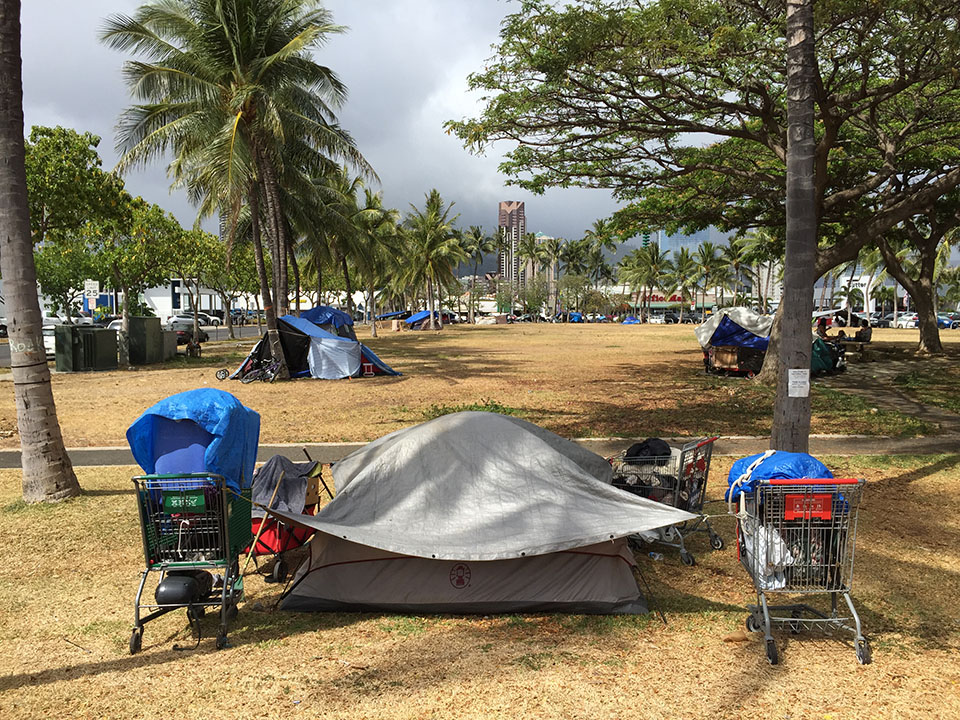
Yet many Micronesians living in Hawaii feel their contributions are not being reciprocated. As noncitizens, they can’t vote. (Although they can live and work freely in the United States, in order to become citizens they must first apply for green cards, which they can’t receive unless they have certain job skills or relatives who are legal permanent residents.) Worse, they’ve lost access to federal safety net programs to which they were once entitled.
“We gave up a lot for the Compact of Free Association,” said Jojo Peter, a native of Chuuk and co-founder of the COFA Community & Advocacy Network, based in Honolulu. “Almost all of the Northern Hemisphere between Japan and Hawaii has been given to the United States exclusively for its military purpose.”
Peter continued, “And then we come here and pay taxes just like everybody else, but we don’t have access to the same thing that we pay for. So for us, it’s like we’re paying over and over again for this treatment that we expect to be fair.”
The Marshall Islands and the FSM have the highest rates of diabetes in the world, according to a 2014 survey from the International Diabetes Federation, due largely to the introduction of a Western diet. But there are no dialysis centers in the Marshall Islands or Chuuk, and treatment for other ailments, including cancer, is limited. (Some studies have linked elevated cancer levels in parts of Micronesia to radiation from the nuclear tests, although the science is not settled.) As a result, health care, along with education, is now the most cited reason Micronesians migrate to Hawaii.
But in 1996, 10 years after COFA was signed, a provision of the landmark welfare reform bill, introduced by then-Rep. John Kasich of Ohio and signed by President Bill Clinton, revoked the right of some immigrants to Medicaid and other federal programs, such as food stamps and Temporary Assistance for Needy Families (TANF) stipends. Certain immigrant groups were granted an exception to this change, but the COFA population was not.
“I don’t think anyone thought about the implications for Micronesians,” said a US government official who has worked on Micronesian affairs for many years but was not authorized to speak on the record. “Once it had happened, it was like, ‘Oh, shit.’ And there were almost immediately efforts to put it back.”
But revoking funding for a niche constituency is a lot easier than restoring it, particularly when that population can’t vote. The Hawaiian delegation to Congress has unsuccessfully introduced measures to restore federal benefits to COFA migrants. In the current political climate, the chances of a Republican-controlled Congress appropriating funds for a virtually unknown migrant group with no political voice is effectively zero. The result is a peculiar imbalance: Legal immigrants from most foreign countries gain access to federal benefits such as Medicaid after five years in the United States, but migrants from the COFA countries, who enjoy the unique privilege of unfettered residency in America, do not.
Micronesians who come to Hawaii in search of medical care or economic opportunity find instead that they can’t afford the treatments they’re seeking or the cost of living, the highest of any state. Isolated from the mainland and limited in the supply of increasingly valuable land, Hawaii ranks first in the cost of housing, utilities, groceries, and transportation. Honolulu is the most expensive metropolitan area in America. The growing number of Micronesian arrivals in recent years has coincided with annual increases in Hawaiian homelessness for each of the past five years and a rising share of the homeless who are unsheltered, which reached 50 percent last year.
Like Jaymiola and Jerana, most arrivals from Micronesia don’t take directly to the streets. Many land first in public housing. But they often don’t last long. Micronesian cultures are built around family ties, and extended families are accustomed to living together. So Micronesian families of a dozen or more people, unfamiliar with the rules and customs, pack into small public-housing apartments. The result is often eviction, or departure before an eviction can take place.
The most common complaint among Micronesians living in Hawaii is discrimination. For a state where one-fifth of the population was born in another country, Hawaii has a heritage of entrenched stereotypes against the latest immigrant group. Samoans bore the brunt of it until Micronesians began arriving.
Hawaii state spending on COFA population (in millions):
In Kakaako Waterfront Park, perhaps 100 yards from Jaymiola and Jerana, three women shared a tattered, makeshift tent. They were all native Hawaiians, and they scoffed when I said I was writing a story about the challenges facing Micronesians in the state.
“This is Hawaii,” said one, who declined to give her name. “It’s hard for everyone. It’s expensive.” She complained, “If you try to get welfare, you won’t get it. But the Micronesians will get it.”
Micronesians have become the present-day Hawaiian version of the welfare queens of Reagan-era America. Many locals, a rung or two up the economic ladder from the new Micronesian arrivals, view them as lazy, unmotivated, and entitled—common stereotypes for any new migrant group—and think they’ve come to the United States to live regally on public largesse. The problem, of course, is that they’re no longer eligible for most federal benefits. They’re welfare queens who don’t qualify for welfare.
Inflated reports of the Micronesian presence at Honolulu’s homeless encampments, fueled by these stereotypes, have skewed perceptions of the share of the homeless who are Micronesian and the share of Micronesians who are homeless. It’s hard to come by exact figures, but two things are clear: Contrary to widespread beliefs, COFA migrants do not make up a majority of Hawaii’s homeless residents, but they do represent a share of the homeless that’s vastly disproportionate to their overall population. Josie Howard, who runs We Are Oceania, a Honolulu nonprofit that assists Micronesians with housing, health care, and employment (and where Jojo Peter serves as community advocacy manager), estimates that about 40 percent of her clients are homeless. But that’s just the people who sleep on the streets or in shelters. An additional 30 percent or more are what she calls “hidden homeless,” often living off-lease with friends or relatives and at risk of falling into homelessness at any moment.
On the day I visited the emergency family shelter operated by the Institute for Human Services (IHS), Honolulu’s oldest and largest homeless services provider, 76 percent of the families staying there were Micronesian, according to Kimo Carvalho, IHS’s community relations director. Many of them had arrived in the summer and fall of 2015, when officials undertook the first big sweeps of Kakaako and another growing homeless encampment along the banks of the Kapalama Canal.
“The one day they evicted everyone from Kakaako, it was a race to IHS,” said Carvalho. “We filled up in 10 minutes.”
Janet Lorenzo was part of the wave who sought shelter at IHS following last year’s sweeps. She grew up in Chuuk and moved to Honolulu four years ago, spending three of them living in Kakaako Waterfront Park.
“Not fun” is how she described her time there. “There’s no life. I cook under the rain. When the typhoon came, it’s all flooded. It’s hard.”
Still, she was reluctant to seek shelter, wary of the tight rules and curfews she’d heard about. But when the sweeps began last year, Lorenzo gave in and visited IHS, where she still lives with her husband and daughter. She teaches English to the growing population of Chuukese students at a local elementary school, and her husband washes dishes.
Sweeps by city and state officials have made life on the streets a constant hassle. But that’s also part of the strategy.
“People say sweeps don’t work,” said Carvalho. “But Janet Lorenzo’s here.”
Joey Manahan, a member of the Honolulu City Council, was one of the reluctant authors of the laws that have led to the crackdown across the city. His district includes the bulk of the city’s public housing and Micronesian residents. On a scorching spring afternoon, we went for a drive along Honolulu’s homeless migration route in his Honda Element. We started in Waikiki, the heart of Honolulu tourism and the first epicenter of the city’s homelessness crisis. Homeless residents had lined the sidewalks of the upscale hotel district, until business owners and tourism officials persuaded the city to implement its first sit-lie ban in late 2014. The rules imposed by sit-lie are simple: On the sidewalks of the demarcated area, you can’t sit, and you can’t lie. Put another way, you can’t be homeless.
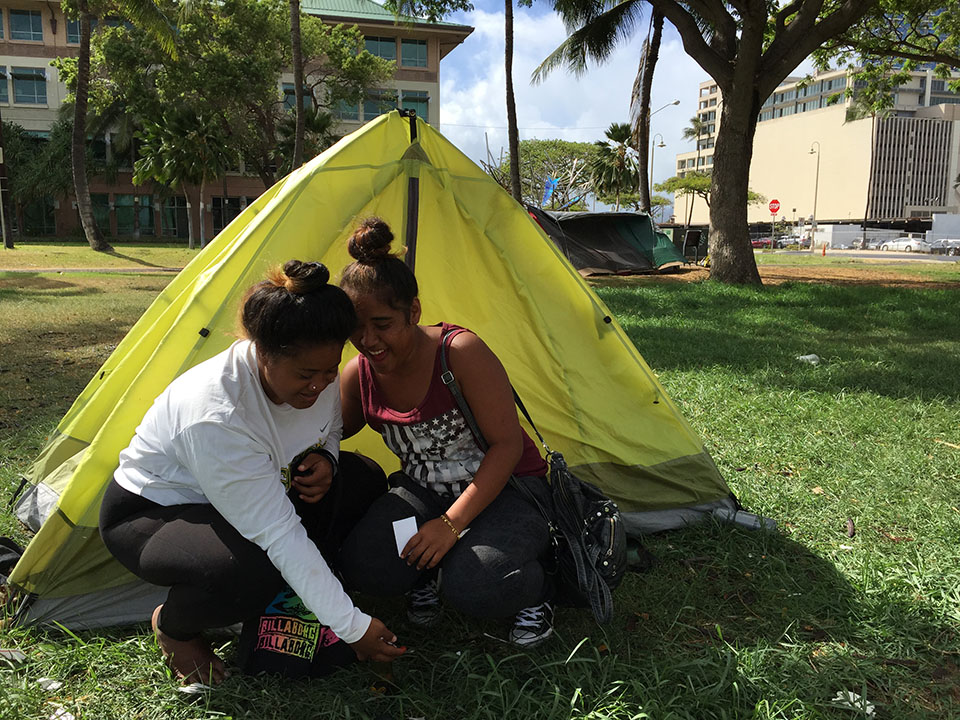
So the homeless moved to Ala Moana Park, a green expanse along the shore, facing shimmering high-rises under construction. As the homeless population pushed west, so did the sit-lie ordinances. Chinatown and downtown joined the list. In the Kalihi neighborhood, in Manahan’s district, homeless residents began to sleep along the Kapalama Canal.
“I had over 100 campers at one point,” Manahan said, showing me a photo on his phone. “There were a lot of singles and couples on one side of the canal. And on the other side were all the families. And there were a lot of COFA families.”
Under pressure from nearby businesses, Manahan and the City Council imposed a sit-lie ban for the canal area, overriding the mayor’s veto, and erected a fence along the canal. The homeless residents moved on once again. Manahan doesn’t like resorting to sit-lie bans, saying, “Our policy for homelessness is: Out of sight, out of mind.” But business owners have raised hell at meetings with him. The Micronesians in his district can’t vote. It’s hardly a fair fight.
The staunchest political advocate for Micronesians living in the United States operates far from the streets of Kakaako and Kalihi. Esther Kia’aina, the assistant secretary of the interior, established the $250,000 annual grant that funds We Are Oceania’s one-stop center in Kalihi that’s now the service hub of the Micronesian community. A Guam native, Kia’aina is unapologetically blunt, and when I asked if the federal government was meeting its obligations to Micronesians in Hawaii under COFA, she replied, “Clearly not.”
Kia’aina believes the simplest and most important fix would be to restore Micronesians’ access to federal benefits such as Medicaid. But that would require Congress to mobilize behind an issue it’s shown little inclination to tackle. That’s left Kia’aina as one bureaucrat fighting a lonely battle. “We’re just on our own,” she said. “We’re a tiny office. We have less than 40 staff.” Next month, Kia’aina will depart, handing control to Trump administration officials who may not consider aid to an obscure community of islanders a priority.
The most pressing concern for her office, Kia’aina said, is assisting the population that was at the heart of the migration story’s origins: the Bikinians displaced from their home by nuclear testing. Now, some of these Bikinians are living on an island, designated for them after relocation, “that is being inundated with king tides as a result of climate change.” Their struggle is a window into the future of Micronesia. Climate change is beginning to render some of the islands uninhabitable. Most of the Marshall Islands are less than six feet above sea level, and the battle against rising tides is already underway. The out-migration from Micronesia is likely to accelerate, and the United States is the obvious destination.
Compounding the Micronesian exodus is the island nation’s fiscal situation. The COFA countries rely heavily on US aid: It accounts for half of the total revenue in the FSM and 60 percent in the Marshall Islands. But that aid is set to expire in 2023, and the trust funds that are supposed to replace it are unlikely to be adequate. Again, the Trump administration might not feel much imperative to hand taxpayer dollars to a population with no political voice. By appointing vocal opponents of efforts to combat climate change to top positions, Trump has already signaled that slowing the rising seas is not high on his agenda.
These foreboding omens were far from the minds of Jaymiola and Jerana as they sat in Kakaako Waterfront Park and contemplated their more immediate future, wondering where they would sleep that night.
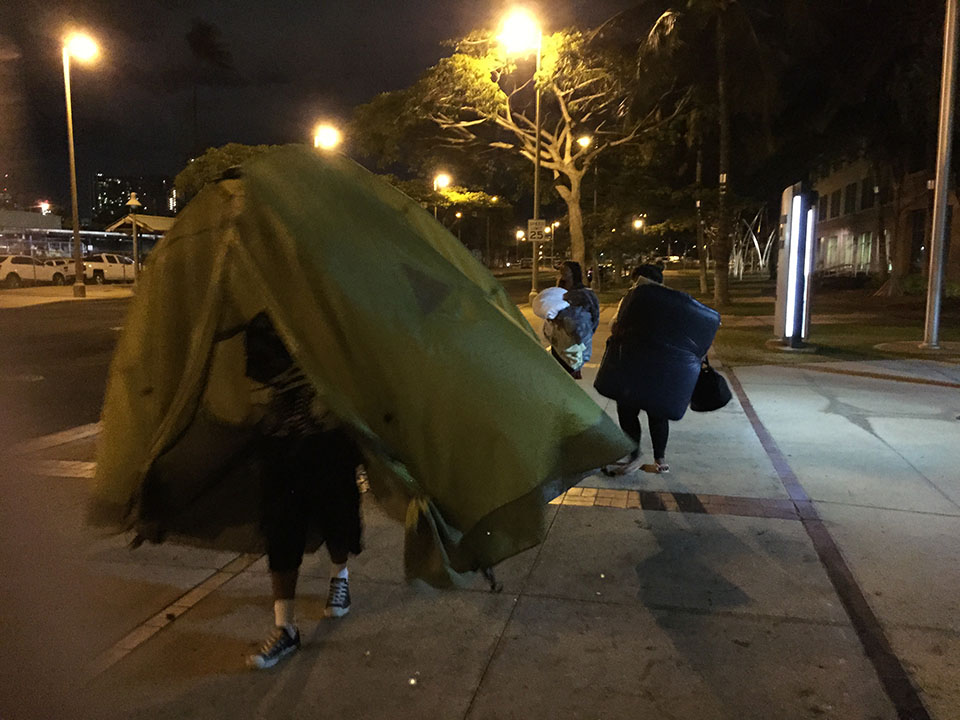
“Out here on the streets, it’s dangerous,” said Jaymiola. “People steal from you.” Their tent was singed on one side, after someone had tried to burn it down.
Social workers have tried to recruit them to the Next Step shelter down the road. But they fear it would be even more destabilizing than life in the park.
“‘Cause we’re gonna get kicked out in the morning,” said Jerana.
“And then it’s just back to the park,” her sister added. For once, she allowed her mind to wander beyond the tedium of their regular migration up and down the same street, beyond their sleeping configurations and the status of their meager possessions. She reflected for a moment on the family decision that took them to Hawaii in the first place, then said, “I regret coming here.”
Reporting for this story was supported by the Fund for Investigative Journalism.
